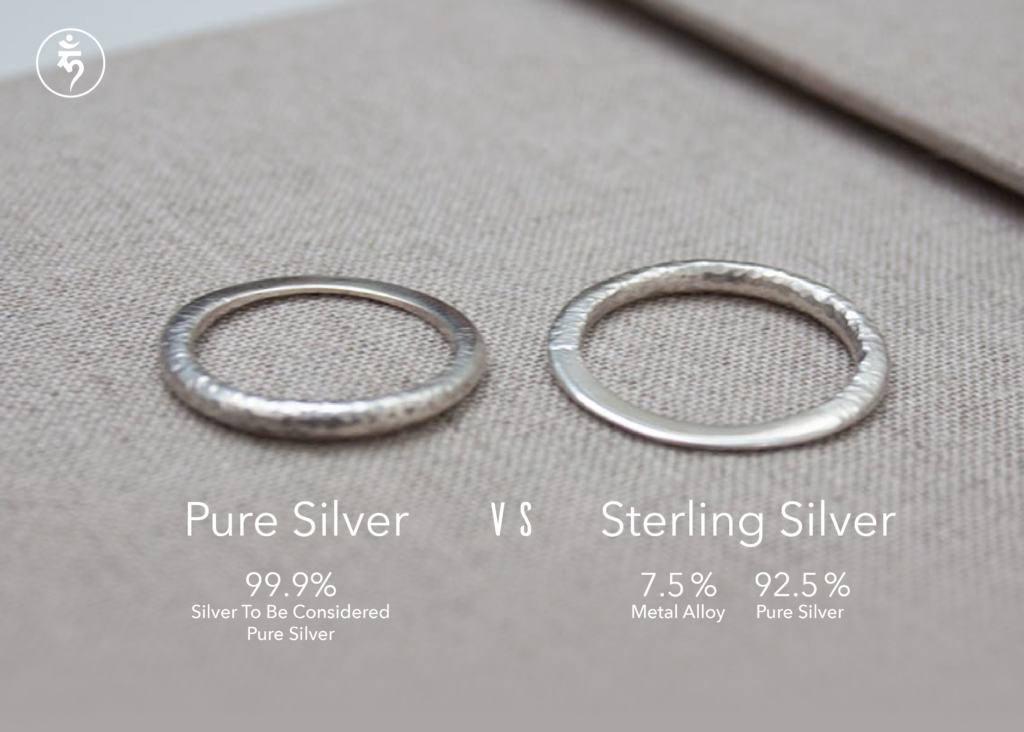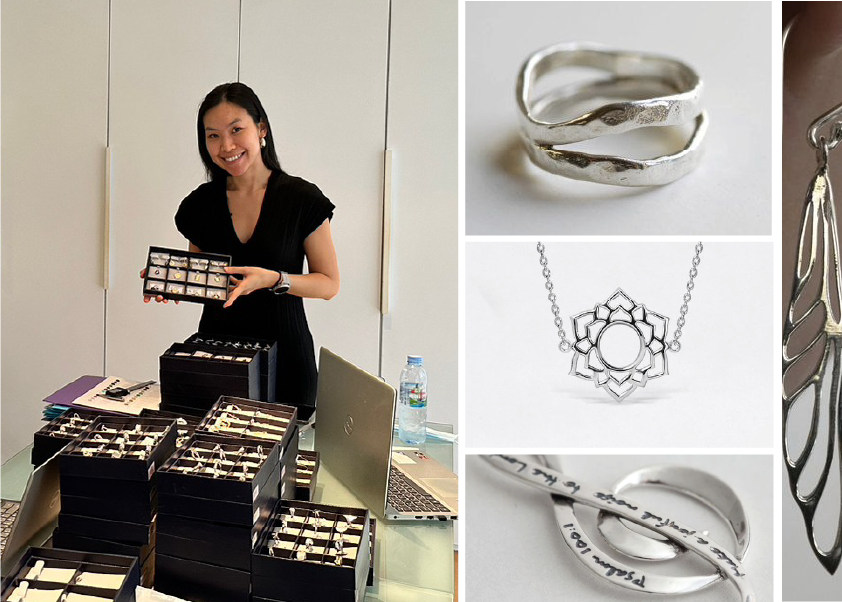Are you in the market for some new jewelry but wondering whether to go for pure silver or the 925 sterling silver? It can be a tough decision, especially if you don’t know the differences between the two. Pure silver and sterling silver may sound like they’re the same, but they have some significant differences in terms of durability, cost, and appearance.
In this blog post, we’ll explore the differences between pure silver and sterling silver. We’ll also delve into what the “925” marking on jewelry means and why paying attention to it is important.
So, whether you’re a jewelry enthusiast or just looking for a new piece to add to your collection, this blog post will help you make an informed decision about whether pure silver or sterling silver is the right choice for you.
What is pure silver?
Pure silver, also known as fine silver, is the closest form of silver to its pure element state. It is highly valued for its high purity percentage, which is commonly identified by quality stamps such as “.999 FS,” “999,” or “99.9.” These stamps reflect the silver alloy’s actual silver content of 99.9%, with the remaining 0.1% consisting of trace elements of insignificant quality.
However, due to its high purity, fine silver is a soft metal that can easily scratch, dent, or change shape, making it a challenging material for jewelry making. Despite this, its exceptional beauty and luster make it a popular choice for creating unique and delicate jewelry pieces.
What is sterling silver?
Sterling silver is a type of alloy that consists of 92.5% pure silver and 7.5% other metals, typically copper and other alloy compositions. The addition of copper to the silver provides additional strength and durability, making it more stable and easier to work with than pure silver. As a result, many of the silver jewelry items available for purchase in the market are crafted from sterling silver.
Have you ever wondered what “925” means on jewelry?
Sterling silver is a compound made up of 92.5% pure silver and 7.5% other metals, usually copper. The 925 sterling silver markings indicate the actual silver content in the alloy. The addition of copper increases the hardness of the alloy, transforming it into a much more durable material for jewelry making. The quality of sterling silver is often identified by the hallmark stamp of “.925”, “925 STG”, or “92.5”, which allows jewelers to produce intricate and complex designs of jewelry pieces with sterling silver.
Although sterling silver is harder than pure silver, it is still prone to scratches and tarnishing. To prevent this, a layer of plating can be applied using gold to change the color, or rhodium to enhance the safety guard over the jewelry surface. By taking these precautions, sterling silver jewelry can retain its beauty and durability for years.
Why choose silver 925 over pure silver?
The difference between sterling silver vs. pure silver is highly influenced by the following factors:
Cost – When it comes to silver, purity is directly proportional to cost. Real silver, which has a higher purity than sterling silver, is generally more expensive. However, silver 925 is a popular alternative due to its relative affordability. Despite being less pure than real silver, silver 925 retains its beauty and lustrous appearance. Therefore, it is an excellent choice for those seeking an affordable option.
Durability Factor – The added metal alloys in sterling silver makes it significantly stronger and more durable compared to fine silver. This durability ensures that jewelry pieces made from sterling silver can last longer while retaining their design and appeal. Copper is the most commonly chosen metal for creating the alloys used in sterling silver. It offers excellent durability, stability, and longevity, making it a reliable option for creating high-quality sterling silver pieces.
Easier to shape – The design complexity of a piece of jewelry can significantly increase its value. Pure silver is known for being soft and malleable, whereas sterling silver (also known as 925 silver) is much stronger and more pliable. This makes it easier to create intricate and unique designs with 925 silver jewelry. Furthermore, sterling silver is easier to resize, repair, and polish compared to other types of jewelry. And when scratches or scuffs appear, sterling silver can be easily restored to its original luster.

HOW DO YOU KNOW YOU HAVE A REAL 925 STERLING SILVER?
There are techniques that can help you to identify real sterling silver from the fake silver jewelry that is available in the market.
Clean your jewelry – Use a soft white polishing cloth and rub it gently. If you notice any black marks on the cloth after rubbing, it’s a good sign that the jewelry is made of genuine sterling silver. This is because the polishing action removes the oxidized layer that naturally forms on silver over time, revealing the shiny, unblemished metal beneath.
Perform the nitric acid test – Begin by adding a single drop of nitric acid to the surface of the jewelry. If it is authentic, the surface will remain unchanged. However, if the jewelry is made of fake silver or is silver-plated, the area with nitric acid will turn green due to the presence of impurities such as nickel. In contrast, real sterling silver will turn creamy in color when exposed to nitric acid.
Note: Remember to wear gloves and goggles to protect your hand and eyes during the nitric acid test.
Perform a smell test – If you detect an unpleasant odor, it could be a sign that the item contains an excessive amount of copper. True sterling silver should not have any discernible scent.
Perform magnet test – A magnet should have no impact on fine silver or sterling silver. If a piece of jewelry is attracted to a magnet, it is likely not made of authentic sterling silver but rather silver-plated over a base metal.
Identify the quality stamp marking – Determining the authenticity of sterling silver is quite simple, as the markings are straightforward. A genuine sterling silver piece will have a stamp with markings such as “.925”, “92.5”, “925”, “Ster,” or “Sterling Silver” in a hidden area or behind every piece of jewelry.
CONTACT US TODAY!
In conclusion, sterling silver and pure silver have their own unique characteristics and qualities. Pure silver, also known as fine silver, is 99.9% pure silver and is extremely soft, making it difficult to use in jewelry making. On the other hand, sterling silver is a popular choice for jewelry because of its durability and affordability. It is made up of 92.5% silver and 7.5% other metals, which makes it more resistant to wear and tear.
If you’ve ever come across the number “925” on your silver jewelry, it is an indication that it is made of sterling silver. The number 925 represents the purity level of the silver used in the jewelry, which is 92.5%. This hallmark guarantees that you’re getting the real thing and not a cheap imitation.
When choosing between pure silver and sterling silver, it’s important to consider your needs and preferences. While pure silver is ideal for certain types of jewelry, such as fine art pieces, it may not be suitable for everyday wear. Sterling silver, on the other hand, offers a great balance of affordability, durability, and style.
Overall, both pure silver and sterling silver have their own advantages and disadvantages. But if you’re looking for a beautiful and durable material for your jewelry collection, sterling silver is a way to go!
So, if you plan to add sterling silver to your jewelry collection or want to improve your existing designs, it’s crucial to source from a reputable supplier. It’s equally important to choose a reliable destination known for crafting authentic sterling silver with exceptional quality and sophisticated designs.
One such destination is Thailand, which has a well-earned reputation for producing high-quality sterling silver jewelry. Thailand offers a range of beautiful designs crafted with premium materials. To learn more about why you should source your sterling silver from Thailand, CLICK HERE.
And aside from Thailand, at Deepwear, we can help you connect with several manufacturers of sterling silver worldwide. With our in-house team of jewelry specialists and a large network of sterling silver jewelry suppliers, you can rest assured that you’re getting the real deal. CONTACT US today to get started!



